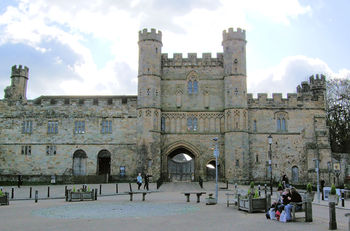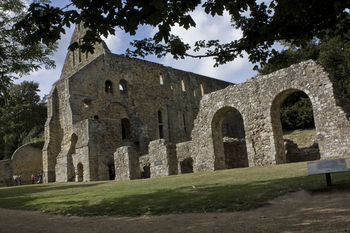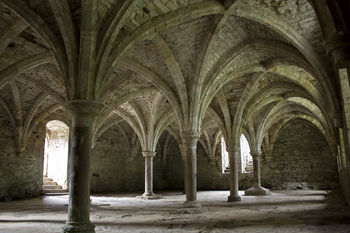Battle Abbey: Difference between revisions
imported>Richard Nevell No edit summary |
imported>Richard Nevell No edit summary |
||
| Line 3: | Line 3: | ||
{{Image|Battle Abbey gatehouse, 2008.jpg|right|350px|Battle Abbey's 14th-century gatehouse}} | {{Image|Battle Abbey gatehouse, 2008.jpg|right|350px|Battle Abbey's 14th-century gatehouse}} | ||
{{Image|Battle Abbey east range, 2009.jpg|right|350px|The east range of Battle Abbey}} | {{Image|Battle Abbey east range, 2009.jpg|right|350px|The east range of Battle Abbey}} | ||
{{Image|Battle Abbey east range vaulting, 2009.jpg|right|350px|Vaulting within the east range}} | |||
'''Battle Abbey''' was founded as a [[Benedictine monk|Benedictine monastery]] by [[William the Conqueror]] in the late 11th century on the spot where King Harold was killed during the [[Battle of Hastings]]. With [[Dissolution of the Monasteries]] in the 16th century under [[Henry VIII]] Battle Abbey was taken under secular control and many of its buildings [[demolitions|demolished]].<ref>Coad, Jonathan (2007). ''Battle Abbey and Battlefield''. London: English Heritage. p. 3. ISBN 978-1-905624-20-1.</ref> | '''Battle Abbey''' was founded as a [[Benedictine monk|Benedictine monastery]] by [[William the Conqueror]] in the late 11th century on the spot where King Harold was killed during the [[Battle of Hastings]]. With [[Dissolution of the Monasteries]] in the 16th century under [[Henry VIII]] Battle Abbey was taken under secular control and many of its buildings [[demolitions|demolished]].<ref>Coad, Jonathan (2007). ''Battle Abbey and Battlefield''. London: English Heritage. p. 3. ISBN 978-1-905624-20-1.</ref> | ||
| Line 11: | Line 12: | ||
The Dissolution of the monasteries was conducted in the late 1530 under King Henry VIII. As part of this, on 27 May 1538 Battle Abbey was given over to the control of Dr Richard Layton, an official of the Crown. The monastic community consisted of an [[abbot]], John Hammond who was given a pension of £100, and 16 monks. In August that year and much of its associated land was given by Henry to Sir Anthony Browne. Under his ownership much of the abbey complex was pulled down, including the church, chapter house, and refectory. An inventory of the abbey's contents was conducted by Layton when it was taken over by the Crown, and he remarked "so beggary a house I never see, nor so filthy stuff". Three years earlier the Abbey had an income of £880, making it one of the richest Benedictine houses in England. Layton's testimony likely means the monks had been removing valuables from the Abbey in anticipation of its seizure by the king.<ref>Coad, ''Battle Abbey and Battlefield'', pp. 41–42.</ref> | The Dissolution of the monasteries was conducted in the late 1530 under King Henry VIII. As part of this, on 27 May 1538 Battle Abbey was given over to the control of Dr Richard Layton, an official of the Crown. The monastic community consisted of an [[abbot]], John Hammond who was given a pension of £100, and 16 monks. In August that year and much of its associated land was given by Henry to Sir Anthony Browne. Under his ownership much of the abbey complex was pulled down, including the church, chapter house, and refectory. An inventory of the abbey's contents was conducted by Layton when it was taken over by the Crown, and he remarked "so beggary a house I never see, nor so filthy stuff". Three years earlier the Abbey had an income of £880, making it one of the richest Benedictine houses in England. Layton's testimony likely means the monks had been removing valuables from the Abbey in anticipation of its seizure by the king.<ref>Coad, ''Battle Abbey and Battlefield'', pp. 41–42.</ref> | ||
Sir Anthony Browne adapted the abbot's lodgings to act as a residence. Ownership of the abbey descended through the Browne family until 1721 when Anthony Browne, the sixth Viscount Montague, sold the abbey and its 3,200 hectare estate to Sir Thomas Webster. Though rarely in residence, the family had a serious influence on the fabric of the abbey: aside from the demolition conducted by Sir Anthony Brown, the kitchen was dismantled in 1685 under orders from the fourth Viscount Montague. There was some building work, and in 1592 a courthouse was built next to the great gatehouse which still acts as the main entrance. Under the Webster family the abbey underwent further changes, with the partial demolition of the guest house while the surrounding area fell into a dilapidated state. In the late 18th century Sir Godfrey Webster sold parts of the Battle Abbey estates to pay off gambling debts, and the remaining abbey buildings lapsed into a state of disrepair..<ref>Coad, ''Battle Abbey and Battlefield'', pp. 42–43.</ref> | |||
==References== | ==References== | ||
{{reflist}} | {{reflist}} | ||
Revision as of 14:46, 7 November 2012
Battle Abbey was founded as a Benedictine monastery by William the Conqueror in the late 11th century on the spot where King Harold was killed during the Battle of Hastings. With Dissolution of the Monasteries in the 16th century under Henry VIII Battle Abbey was taken under secular control and many of its buildings demolished.[1]
William the Conqueror most likely founded Battle Abbey as part of the penitence imposed on him by Pope Alexander II for waging war on the English.[2][3]
Dissolution and Private Ownership
The Dissolution of the monasteries was conducted in the late 1530 under King Henry VIII. As part of this, on 27 May 1538 Battle Abbey was given over to the control of Dr Richard Layton, an official of the Crown. The monastic community consisted of an abbot, John Hammond who was given a pension of £100, and 16 monks. In August that year and much of its associated land was given by Henry to Sir Anthony Browne. Under his ownership much of the abbey complex was pulled down, including the church, chapter house, and refectory. An inventory of the abbey's contents was conducted by Layton when it was taken over by the Crown, and he remarked "so beggary a house I never see, nor so filthy stuff". Three years earlier the Abbey had an income of £880, making it one of the richest Benedictine houses in England. Layton's testimony likely means the monks had been removing valuables from the Abbey in anticipation of its seizure by the king.[4]
Sir Anthony Browne adapted the abbot's lodgings to act as a residence. Ownership of the abbey descended through the Browne family until 1721 when Anthony Browne, the sixth Viscount Montague, sold the abbey and its 3,200 hectare estate to Sir Thomas Webster. Though rarely in residence, the family had a serious influence on the fabric of the abbey: aside from the demolition conducted by Sir Anthony Brown, the kitchen was dismantled in 1685 under orders from the fourth Viscount Montague. There was some building work, and in 1592 a courthouse was built next to the great gatehouse which still acts as the main entrance. Under the Webster family the abbey underwent further changes, with the partial demolition of the guest house while the surrounding area fell into a dilapidated state. In the late 18th century Sir Godfrey Webster sold parts of the Battle Abbey estates to pay off gambling debts, and the remaining abbey buildings lapsed into a state of disrepair..[5]
References
- ↑ Coad, Jonathan (2007). Battle Abbey and Battlefield. London: English Heritage. p. 3. ISBN 978-1-905624-20-1.
- ↑ Coad, Battle Abbey and Battlefield, p. 32.
- ↑ Bachrach, David S. (2003). Religion and the Conduct of War: c.300 – c. 1215. Woodbridge: Boydell Press. p. 77. ISBN 0-85115-944-3.
- ↑ Coad, Battle Abbey and Battlefield, pp. 41–42.
- ↑ Coad, Battle Abbey and Battlefield, pp. 42–43.


